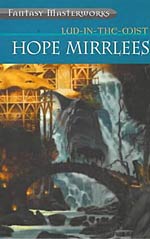
![]() thrak
thrak
1/9/2013
![]()
"It was as if the future were a treacly adhesive fluid that had been spilt all over the present, so that everything he touched made his fingers too sticky to be of the slightest use."
Hope Mirrlees only wrote one fantasy novel. 'Lud-In-The-Mist' comfortably predates Tolkein and Peake's defining works of 20th Century English fantasy, yet it still feels wonderfully fresh and decidedly odd. Lud is situated on the confluence between two rivers: the Dawl, bringing trade and prosperity from inland, and the Dapple, which flows from the land of Faerie. The citizens of Lud have renounced all things magical, and with the growing influence of the supernatural preying on the town, it's up to Nathaniel Chanticleer, the town's mayor, to put things right.
Though here be elves and faeries, they couldn't be further away from Tolkein's wise, good-natured and somewhat twee creations. Mirrlees takes her cues from folklore; the Fairies are mischievous and cunning, and as in folklore, Faerieland is conflated with the land of the dead. As in John Crowley's 'Little Big', which I am sure must have taken some of its cues from this book, the sense of threat is created by the encroachment of the world of Faerie on our reality.
None of this really conveys the great strength of the book, which is Mirrlees' writing style itself. 'Lud-In-The-Mist' gleefully and effortlessly shifts through differing styles and tones whilst maintaining a constant and engaging narrative voice. Throughout the book the wordplay is a delight, and is used by the author to set up and subvert expectations. As a result, you get wonderfully vivid mixed or extended metaphors, like the one I've quoted above. This all adds to the synaesthetic feel of the novel, which really helps at the end where Master Chanticleer rides into the land of Faerie and things get seriously trippy.
And then there are her characters. Chanticleer himself is a wonderfully unlikely hero, a bumbling, self-important dreamer; yet his heart is absolutely in the right place so you can't help wanting him to succeed. Among the more villainous characters, her descriptions almost achieve the grotesque surrealism of Mervin Peake's 'Gormenghast', although Mirrlees is more gentle in tone, and even the villains remain sympathetic. After all, the book is ultimately about the reconciliation between the magical and the mundane, as represented by the worlds of Lud and Faerie. A theme throughout is how we need something of the magical in our everyday lives, how the power of words to name things and so to deceive is itself a kind of magic. This kind of meta twist, which finishes off the novel very elegantly, wouldn't be out of place in Gene Wolfe's work. But 'Lud-In-The-Mist' predates all that. It's a testament to the power and originality of this novel that you can feel its influence in much of the more adventurous Fantasy novels so many years on.
http://goldenapplesofthewest.blogspot.co.uk/2013/01/hope-mirrlees-lud-in-mist-1926.html